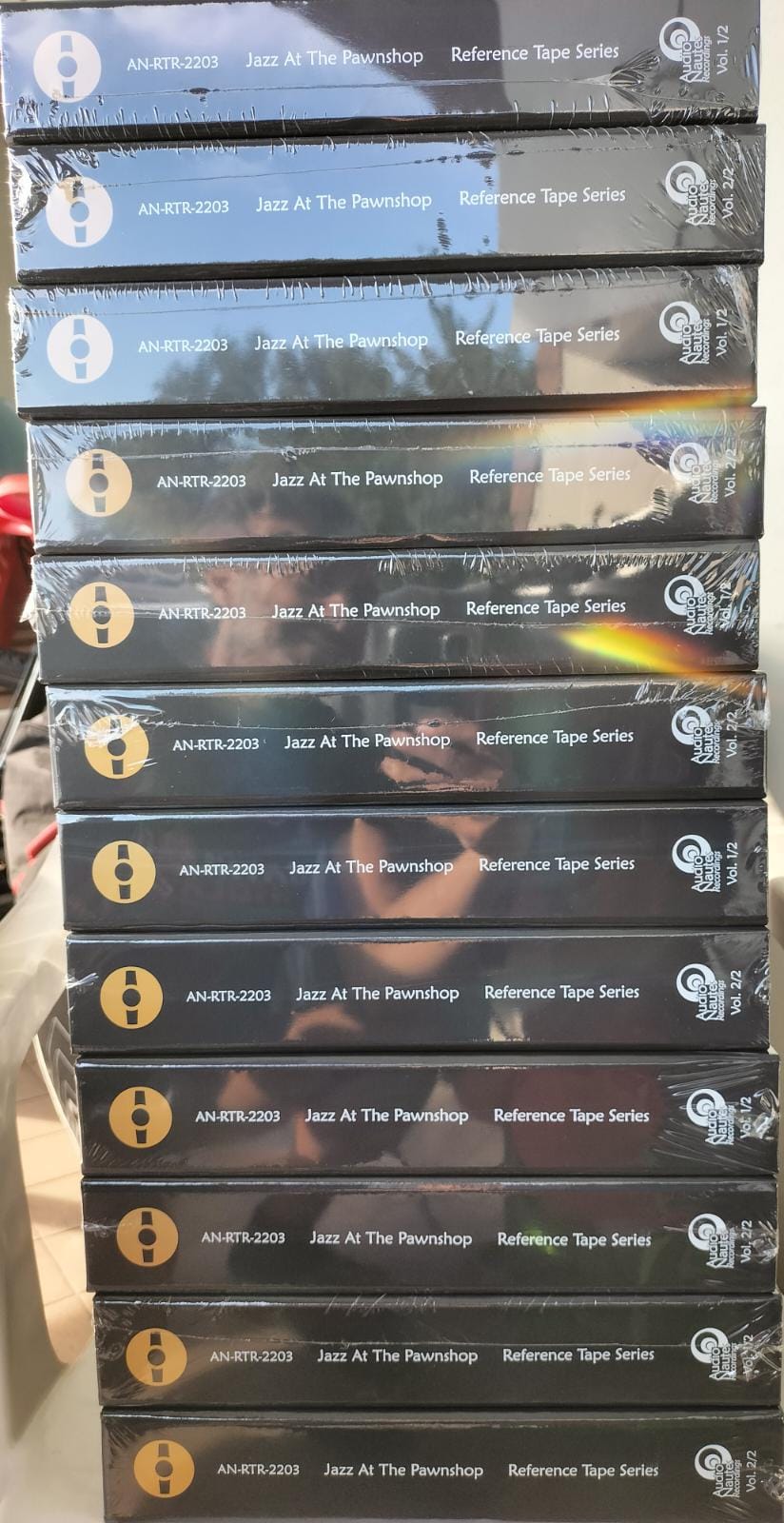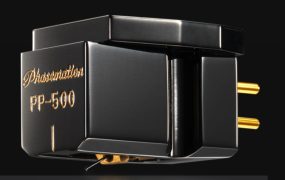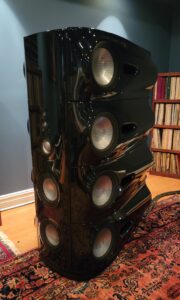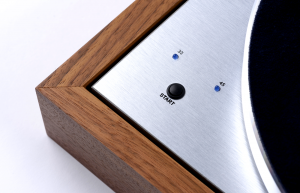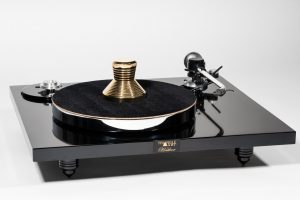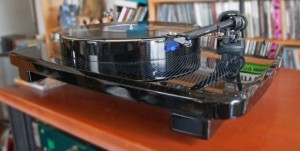
Dogma is defined in the dictionary as, "A belief or set of beliefs that is accepted by the members of a group without being questioned or doubted." For some audiophiles—and everyone has an audiobuddy or two or three that fits this description—that dogma could be solid-state vs. tube electronics, planar vs. dynamic speaker, analog vs. digital—or even in the case of this review, the sound of belt/rim drive vs. direct-drive turntables. But even scientific dogmas, take the cases of jumping genes, division of brain neurons or even localization in the brain, are clearly not etched in stone.
Until quite recently, belt-drive (or some sort of idler wheel variation) turntables ruled the roost. Direct-drive tables? Run for the hills! Sadly, the first direct-drive tables of the late '60s and early '70s such as the Technics SP10Mk.1 failed, because of a host of issues including noise transmission, cogging effects, speed instability and ringing platters among other things, to live up to expectations. Which was too bad because who didn't love a turntable that came up to speed faster than a dropped record hitting the floor and didn't need its belts replaced every year? Heck, one could stand on the platter and it would rotate at the correct speed! Of course there were always exceptions to the rule along the way such as the Goldmund Studio and Rockport turntables but the vast majority of yesterday's and even today's best turntables continue to put the rubber to the road. (Not to mention that the price of the direct-drive tables limited their widespread distribution.)
But when push comes to shove, is it the technology or its implementation that's the issue with direct-drive turntables? It wasn't until the release of the Continuum and especially in my mind, the Steve Dobbins modified Technics SP10 Mk. III turntables, that there was a definitive answer to that elusive question. Dobbins' The Beat turntable in particular possessed a solidity, transparency and resolution—not to mention a flow to the music—that eludes many of today's turntables.
Did Those Early Direct-Drive Tables Have it Right?
Harry Weisfeld is one of today's most respected and longest tenured high-end turntable designers. Few, if any designers, have more of a track record with belt drive turntables than does Weisfeld. So it's the lead story on the six o'clock news when VPI's newest top-of-the-line turntable turns out not to be a belt but a direct-drive motor design. So why did Harry Weisfeld make a 180-degree about face in his design philosophy? Read on.
Designer Weisfeld has worked tirelessly over the years to reduce his turntable's "sonic signature." Prior to the release of the new Classic Direct, the biggest sonic improvement in the VPI table line was unquestionably the addition of the Classic's aluminum platter. Gone was that hazy-like transparency, slight dynamic reticence and laid back quality that defined the VPI turntable sound. With the release of the new direct-drive Classic Direct turntable, however, designer Weisfeld has taken a revolutionary rather than an evolutionary step forward with his turntable designs. The combination of the Aluminum platter with a new drive motor system, the new 3D printed arm wand and a few other changes has elevated the sound of the VPI Classic Direct to an entirely new performance level.
In fact, the changes wrought by the insertion of the VPI Classic Direct turntable into the audio system (coupled with the recent addition of the Doshi phono stage) were so profound that it again rekindled the age old question of whether the issue with the analog playback lies with the technology itself (as our digital audiobuddies would like us to believe), the record mastering and production process or that not so simple act of extracting the information from the grooves of 12-inch black disc? Dismissing the first possibility, the answer has for many years flip-flopped between the latter two possibilities with alternating improvements in turntable, phono section and cartridge design not to mention tape decks and production facilities like RTI, Pallas and QRP.
After all, accurately and completely retrieving all the information from that spinning black disc is no facile task. Maintaining both micro-and macro speed stability as well as the arm/cartridge perfectly motionless over the record groove are just two of the many issues that must be addressed. Then once that information has been transcribed from the record groove, there's the issue of phono-stage e.g.. noise, overload factors, sensitivity to high frequency peaks, noise, amplification, etc. If the VPI Classic Direct turntable with its superstable speed stability and new extremely low resonance 3D printed arm coupled with the latest generation of phono cartridges and phono sections are any indication, the fault today lies more with the translation of the information off the disc (sure a lacquer sounds better than the final production product and that might close the tape/LP gap even further), not the medium. The Classic Direct shows there's infinitely more information and fidelity to the tape on the LP than ever imagined. (After all, is the fidelity to the master tape or the original recording?)
More to the point, here's where all that time, money and effort spent rebuilding that'70s vintage Technics RS1500 reel-to-reel tape deck (new heads, electronics, tape path modifications) really paid off. Not only did I undertake rebuilding the Technics machine for its reference quality sound but as a baseline for turntable performance. Just how close, for example, does that turntable/arm/cartridge/phono section combination come in the case of parallel tape and record, to the sound of the tape deck (or arm or cartridge)? The answer in the case of the VPI Classic Direct is that the two analog based mediums have more than a passing resemblance. Maybe not identical but we're definitely looking at fraternal twins. Audiophiles intimately familiar with sound of what the best in analog tape has to offer (especially with that head bump smoothed out) will truly appreciate the Direct's almost limitless sense of dynamics and explosive impact. There's absolutely no mistaking the Classic Direct's faithfulness to the sound of an early 15-ips generation tape particularly when it relates to capturing the musical dynamics, especially in the lowest octaves. Mated to the ultra-quiet, resolving and dynamic Doshi Audio phono section really allows the Classic Direct table's lack of compression and most notably that sense of dynamic ease on demanding passages to shine through. With the Atlas cartridge riding in the 3D arm wand, the table really captures more of each individual drum's dynamic impact, punch and shadings on Chavez's "Toccata for Percussion" from that old-time reference Super Percussion (Super Analogue SSY 19).
At the same time, the Classic Direct interestingly both brings the tonality and neutrality of different moving coil cartridges—that in the course of this review included the likes of the Ikeda 9TT, the Lyra Atlas, the Transfiguration Proteus and the Koetsu Azule Blue—closer together than ever thought possible and yet at the same time, clearly defines their respective signatures. The absence of overt turntable and arm colorations (much like HP heard many years ago after taking receipt of the Goldmund Reference turntable) really allowed this quartet of cartridges to strut their stuff.
On other hand, the subtlest differences in spatial resolution, low level information, dynamics or soundstaging among this quartet of transducers were instantly revealed like pimples on a butt in a HD porn movie. It was in the case of the Atlas, the Lyra's ability to capture the tape-like dynamics and ease (particularly at the bottom end) and the meatiness of instruments. With the Azule Blue, it was the cartridge's amazing knack of recovering the sense of a hall's ambient space and transparency. With the Proteus, it was the cartridge's gift of capturing capture low level resolution such as the reverb around an instrument. Lastly with the Ikeda, it was hands down the cartridge's unfettered and effortless sense of speed. No, the table still doesn't quite have the same amount of information density as on a good 15-ips reel-to-reel tape (a lacquer certainly will come a bit closer but that's only good for a couple of plays), but the Classic Direct takes the medium one huge step closer.

Performance Future Tense
What separates the men from the boys, the contenders from the pretenders, the very best turntables from the also rans, is noise. The renowned SME turntable was at the time of its introduction into the US the first turntable that really gave new meaning to low noise floor and the new Classic Direct follows in the same track. Even without the Silent Running Audio base, the Classic Direct's "quietness" is readily apparent; nonetheless, it goes without saying that a sizeable chunk of the table's low frequency and dynamic performance—not to forget transparency—is directly traceable to the Silent Running Ohio Class XL+2 turntable base. (In fact, the longer one listens to the Classic Direct, the noisier the Reference Super Scoutmaster table with rim drive sounds.) Of course achieving this noise floor requires every part of the audio chain—be it the electronics, sources, cables (don't forget the phono cable!), electricity, vibrations and room acoustics—is up to snuff. On the best of material such as the "All or Nothing" tune from Coltrane's Ballads (ORG/Impulse 45 rpm, AS-32), the Classic Direct's vanishingly low noise floor immediately attracts and directs the listener's eyes all the way to the back the stage and reveals every little nuance, rim strike and resonance of Jones' drums. The wonderfully recorded Tony Faulkner Songs from the Fayrfax Manuscript (Musical Heritage MHS 4649) also nicely illustrates that the table's transparency extends much further up the frequency spectrum as well. The Classic Direct has a real talent for capturing each individual singer and separating the direct and indirect hall sound. More so, it's say with the Atlas, the total information density that leads to greater fleshing out of the singers. So much that one can almost make out their facial features. The table's vanishingly low noise floor allows for on the ATR Mastercut Recording reissue of La Folia (ATR 013), the smallest details—the chirps, beeps, rattling and rolling and more—to emerge from silent background. In the end, it all comes down to the fact that whenever there's a reduction in the system's noise floor, the more the information spigot opens and information flows out. In other words, there's simply a greater ability to suspend disbelief.
Technology Realized?
Turntable speed control ranks right there with Godliness. Not surprisingly, it's the Classic Direct's preciseness, namely the lack of smearing of plucked instruments such as guitars or kotos or the solidity of sustains on a piano, that sets this table apart from the competition. The table's speed stability is nicely illustrated by The "Worried Drummer" cut with its potpourri of percussion instruments from that old standby Mallets, Melody and Mayhem (Columbia CS8333). Whether it's the initial triangle strike and its resultant decay and shimmering or the ability to make out each individual sleigh bell shaking, the Classic Direct just maintains that musical flow. Or it's the snap of strings and the feeling of weight and fullness of Takashi Mizuhashi's bass without any sense of exaggeration or bloat on "Alter" from Masaru Imada's Now (Three Blind Mice TBM-2) that defines the Classic Direct's sound. So far different that this lack of smearing is taken for granted now after listening to the Classic Direct for a period of time.
Surprisingly, speed control not only impacts tonality but soundstage size. That was first observed many years ago when adding the external SDS to VPI's belt drive tables and continues in that vein with the new direct-drive table. While the VPI Reference Super Scoutmaster with its accompanying rim drive is certainly no slouch when it came to soundstaging, the older table is playing in the minor leagues next to the Classic Direct. What's particularly impressive given the proper software, is simply the breadth, width and depth of many a recording. While the 15-ips tapes played back on the modded Technics generally have a wider soundstage than the Classic Direct , there are definitely a few instances where the reverse is true. (this doesn't appear to be a mixing issue of three down to two channels for example).
Of course, it's impossible to separate the sound of the Classic Direct table from the sound of VPI's new 3D arm. No matter what, the 12-inch 3D arm was a breath of fresh air for me having been inexorably stuck for way too long with the 10.5 arm (since the Reference Super Scoutmaster was incapable of accommodating the 12-inch arm). Having played with both linear tracking and pivoted arm over the years, it was readily apparent that each type of arm brings its own set of strengths and weaknesses to the table. On one hand, linear arms reduce tracing distortion and most of all scour the record for low level harmonic and spatial information. Pivoted arms on the other hand, really demonstrate the linear arms' bass issues and all that accompanies proper reproduction of the lowest octaves. And a properly designed and correctly set-up 12-inch tonearm with its decreased headshell offset really strikes the perfect balance between the two arm types quite nicely.
New + Old = Improved
VPI owners (and many audiophiles, too) often wondered what Harry Weisfeld could achieve with an all out, price be damned, turntable. It's also safe to say that no one in their wildest dreams expected Weisfeld's answer would be a direct drive-drive turntable and high-tech, F-35 Lightning lookalike, printed tonearm. But in end, the best things in life are worth waiting for and the Classic Direct was certainly worth the wait. Though by far the most expensive VPI product to date, the Classic Direct still fits in the company's philosophy of providing a great value for their money.
The sound of the new VPI Classic Direct can be summarized with one word: big. Big sound. Big dynamics. Big bass. Not to mention that the Classic Direct's quietness, neutrality, resolution and faithfulness to the music goes far beyond anything Harry Weisfeld has accomplished to date; if he did nothing else, the Classic Direct would be a fitting close to an outstanding career as a turntable designer.
Where the Classic Direct falls short of ultimate in comparison to the original high resolution medium analog tape –and mind you this is to a large extent dependent upon the cartridge—is in the areas of retrieval of ambient information, harmonic overtones and information density. That said, the Classic Direct brought me closer to the sound of 15-ips, 2-track tape in my system than any table I've had the opportunity to audition.
Speeds: 33⅓ and 45 rpm.
Classic Direct turntable
Retail: $30,000 with 12-inch 3D printed arm wand.
Table Set-up
The Classic Direct is like all VPI tables a breeze to set-up. No fuss, no muss. Unlike other VPI tables, however, assembly is a two person operation. One person needs to lower (using the specially made and included T-tool that threads onto the platter spindle) the motor/platter assembly into the plinth; at the same time, their assistant 1) aligns the motor assembly pins with the holes in the plinth; and 2) ensures the wire strap connecting the on/off switch and speed control buttons to the motor doesn't become trapped and damaged.

Home base for the Classic Direct table was a specially ordered Silent Running Audio Ohio Class XL+2 sitting atop a Silent Running Audio Craz rack. The only thing that hadn't been taken into account, though, was the SRA bases' "slippery" surface finish. The isoBases' nanoparticle coating, combined with the ball bearings in the VPI table's feet, was like an ice skating rink. Moral of story: don't lean on the turntable when changing records. (This probably won't be an issue with the soon to be released VPI new feet.)
Each wand was hooked up to the old standby audiodharma cable cooker (and special adaptor for burning in arm wands) burned in for two days before mounting any cartridge (s) in the 3D arm. Take care when mounting cartridges in the 3D arm to not overtighten the mounting screws or the arm could crack (the same holds true for the counterweight set screw)! Lose the attitude if a little bit is good, more is better. Snug is the key word with the epoxy plastic arm. In fact, the Soundsmith Audio cartridge mounting screws really partnered well with the 3D arm.
The 3D printed arm is as light as a feather and it takes a little time to get the feel of the arm especially when adjusting the counterweight to adjust VTF and azimuth. The counterweight/arm junction is very tight and it's a little challenging when making fine tracking force adjustments (though there's new CW with delrin to ease sliding on the way). Luckily VPI includes Soundsmith's Counter-Intuitive with each 3D arm that really aids in fine tuning VTF and azimuth.

One quirk about the 3D arm—and if you stick to one cartridge you probably won't ever run into this issue—is the arm's cueing lever and arm pick-up assembly. As with all VPI arms, the height of the arm curing lever needs to be re-adjusted when switching cartridges. In doing so, make sure because of the "bent" shape of the new cuing device, to carefully position the lever so it doesn't hit the arm when picking the cartridge up off the LP sending the arm askew.
Finally, the HIFI Tuning was still preferred over the stock VPI record clamp even with the Classic Direct. (see http://pollux.positive-feedback.com/Issue52/analog.htm .) The wood-based HIFI Tuning clamp unleashes that last third of three-dimensionality (including a feeling of depth to the instrument) and doesn't have the coldness and "mechanical quality" of the stock VPI record clamp (Note: VPI has a new record clamp coming out).
Technical Highlights: A Sit Down with Classic Direct turntable designer Harry Weisfeld
MBA: Whoever would have thought, given your long term track record with belt driven-tables, that you would design a direct-drive turntable? No bookie in Las Vegas would have given you any odds on that one!
HW: Actually it all began with a Kenwood LO7D turntable from Kavi [Alexander of Water Lily Records]. It [Kenwood] had a horrible arm and I found that by taking parts off it improved the turntable's sound. The table had a great motor, and if you changed to PEEK bearing, etc., the LO7D was a real revelation; much better than other commercial direct-drive tables. Plus the table had great speed stability and no speed variation with 1000 cycle tone on the CBS test record. I also had the JVC TT-101 direct drive motor, the Denon DP-80 and 75, the Technics SP-10 Mk. 2 and the SP-15 plus a number of lesser direct drive Japanese units. All of them had issues with the way they reproduced music but they all got the speed deadly accurate.
MBA: What were some of the lessons you learned along the way in designing the Classic Direct turntable? Why didn't earlier earlier direct-drive table designs take off like the companies anticipated?
HW: I always thought the problem was the motor and the interface between motor and platter. We worked with an engineering company when designing the Classic Direct on the issue of getting the table to run at exact speed. After much testing and listening, we decided on using a three-phase, extremely high pole AC motor of great accuracy in design. Military grade if you will! The motor we chose uses so many poles in a printed circuit design that cogging becomes irrelevant. It isn't like the older direct-drive motors plagued by slight cogging effects. As an example the Technics uses a 16-pole motor, about one-tenth of what you need for truly continuous rotation.
The more poles an AC motor has, the slower it runs as its native speed. At 60Hz, a 12-pole motor runs at 600 rpm and a 24-pole motor runs at 300 rpm. See the difference? To run "natively" at 33.33 rpm you would need roughly 216 poles. That is where the feeding circuit works and sets the speed using a change in frequency and locking that frequency to set the speed. The speed is driven by the frequency, not a DC voltage and feedback loop.
Many of the early direct-drive turntables used brushless DC electric motors and Hall Effect sensors to determine the position of the rotor; that information was then fed to the motor controller. This proved an excellent choice for the sensor (or magnet) and typical life expectancy is quite long. The problem is the sensor is a device that tells you what has already happened as opposed to real time.
A great expression by a motor engineer is "A DC motor knows where it was; an AC motor knows where it is." By contrast, the speed control used with the Classic Direct samples the generator frequency feeding the AC motor plus that 20 pound Aluminum platter and the real time effect of using an AC motor makes up the difference. This plays a significant role in turntable's speed continuity through heavily modulated passages.
The big thing, however, is the number of poles. Most direct drive motors use a finite amount of poles and the power is transmitted to the rotor in a sinusoidal way, pole by pole. This is very simplified but it explains some of what we did not like about older direct drives. With the Classic Direct motor, we use a printed circuit made in a horizontal "V" shape so no pole is over less than three coils at a time. Doing that leads to no dead spots and continuous torque all around the platter rotation.
Another important factor in the design of the direct-drive motor system is the thin gap between the stator and rotor. In the Classic Direct, the platter functions as the rotor and explains why the platter and drive cannot be separated in the field; this gap, done on a CNC lathe is on the order of 0.005 inches. The end result is that it transfers energy very well.
The Classic Direct speed accuracy is way better than test record accuracy and is checked using a magnetic head to read the results. We normally get readings less than 0.01% wow and flutter and noise down near -100dB.
MBA: What about the Classic Direct's new power supply?
HW: We took a look at our current power supply and felt it didn't look good enough for a table of this expense. So we deleted it altogether from the design but not the operating system. For the Classic Direct, we use an AC to 48 V DC power supply to feed the regenerator built into the motor case. All regeneration occurs inside the motor. Basically the new power supply is a 3-phase SDS built into the motor so owners can't tinker with the power supply.
MBA: The Classic Direct's plinth looks similar to that of the other Classic series tables.
HW: In our testing, we've found that a 2-inch MDF and 1/8-inch steel and 60601 aluminum sandwich is both the best sounding and measuring plinth. May not look as cool as other tables but when we put an accelerometer on the plinth, it's very non-resonant. When screwed and glued together, this sandwich forms a very rigid platform. Plus we can very accurately align mounting holes. You always want things in the same place table-to-table.
MBA: Share a little bit with the readers about the development of the new and extremely unique 3D printed arm wand. (Note: In my discussions over the years, Harry's always been an addition by subtraction kind of guy and the 3D arm technology with less and less pieces fits perfectly into his philosophy.).
HW: Conventional metal tonearms and especially their headshells are very costly to manufacture and all the connections make reflection points. Certain parts must be aluminum or stainless steel because weight is needed in certain areas; but aside from those places a one piece design is much better. Computerized 3D printing is much easier nowadays because of advances in computer-aided design and the lowering of the cost of machines large enough to do this to less than $100 K. Now we can even print and manufacture using Al or crystallized steel.
In the end, we decided to use an epoxy resin (that can be mixed differently but our formula is now fixed) because it sounds great and is dimensionally stable. (Best sounding didn't work, it unfortunately wasn't stable) The 3D arm's resonance point is roughly 10 to 15Hz (depending on the cartridge), 1½dB in amplitude and 3 cycles wide. It is essentially a tonearm without tone!
To shield against extraneous RFI and EMI, we use copper tubing in the armwand and ground it to the female bearing. After the arm is printed, the body needs to be sanded down with fine sandpaper and painted after production. Finally, all the screw holes have to be re-tapped after the process.
MBA: Tell us a little about the new tonearm wire used with the 3D arm.
HW: In our listening sessions, we found the new Discovery wire had a better midrange and was more natural sounding though a little less detailed than the wire we previously used.
MBA: Why doesn't—especially with many analog lovers using stereo and mono cartridges—your new SOTA table hold two arms?
HW: While the table will hold two arms, I wanted the Classic Direct to do one in a world class way. We will address the two or three arm Direct Drive sometime in 2015 but for now it is as good as it gets and you can still swap armtubes in 30 seconds! The table can accommodate most other manufacturer's arms so long as they don't require a huge hole.
MBA: Where do you go next with your turntables?
HW: An air suspension for the Classic Direct and possibly multiple arms in a triangular shaped body. I prefer the rectangular shape for turntable design because it is a safety factor when dealing with very expensive cartridges. A $6K plus cartridge hanging out in the air is not for me, but you cannot argue with the consumer. They want a multiple arm, triangular table with the direct drive motor in it.

Side Note: Silent Running Audio OHIO Class XL+2 isoBase
Even the best of turntables under the best of conditions—be they a Tech Das Air Force 1 or VPI Classic Direct—benefit from attention to vibration control.
Now prior to the delivery of the VPI Classic Direct, a great deal of time was spent weighing all the possible options for where to place the turntable. Should the table sit on a vibration isolating platform or air isolation table as each approach has its pro and cons. For instance, the disadvantage of air tables include an inability to instantly adjust to load and weight location, issues with servo control and component height and weight offsets can affect the operation. Not to mention, most of them look like they belong in laboratories. Or should I stick with something proven (and also cheaper than the cost of most air isolation platforms) and a known commodity in my system such as the Silent Running Audio isobases.
In the end, the choice was made to stick with a proven product, though in the case of the Classic Direct, the latest top-of-the-line product from Silent Runnings Ohio Class XL+2 isoBase platform. In contrast to the many vibration isolation platforms on the market, Silent Running Audio eschews the one size fits all approach and instead mates their platform to the product resting on it (with the newest OHIO class platforms, the owners can send them back in most cases and have the platform adapted to whatever product is needed.) One issue with the one size fits all approach with all vibration isolation platforms occurs at that resonance point where energy directed back into the component creating additional issues.
Designer Kevin Tellekamp's design philosophy is very simple: "the elimination of sonic anomalies over the broadest possible bandwidth at the highest possible amplitude." To meet his goals, the OHIO Class XL+2 isoBases addresses issues with: 1) airborne energy (by far the biggest issue); 2) floor-based energy (from inside and outside the room); and 3) equipment-borne energy. To accomplish this, Kevin takes into account a host of issues when designing each OHIO Class XL+2 platform including but not limited to the component's transmission curves, resonant frequency, weight and weight distribution and profile. This greatly aids in optimally coupling the component to the platform's "skin."
Each Silent Running Audio Ohio Class XL+2 isoBase is hand-built and takes about 4-6 weeks for delivery. The heart and soul of the OHIO Class XL+2 platform is its Raft Isolation system (high tensile steel HY-80 high tensile steel) that consists of replaceable vertical and horizontal isolation modules that achieve six degrees of freedom. The isoBases' outer shell consists of a high-pressure, nano-particle composite material whose function is to drain and provide a path for dissipating equipment resonances. The end result is the exercise lowers the component resonance to ~0.5 Hz. By changing the Raft and Trim system (thermal reactive isolation modules) modules, this base is adaptable to literally any component sitting on it and can be updated for use with different components.
Silent Running Audio OHIO Class XL+2 isoBase
Retail: $2600
Silent Running Audio
www.silentrunningaudio.com






